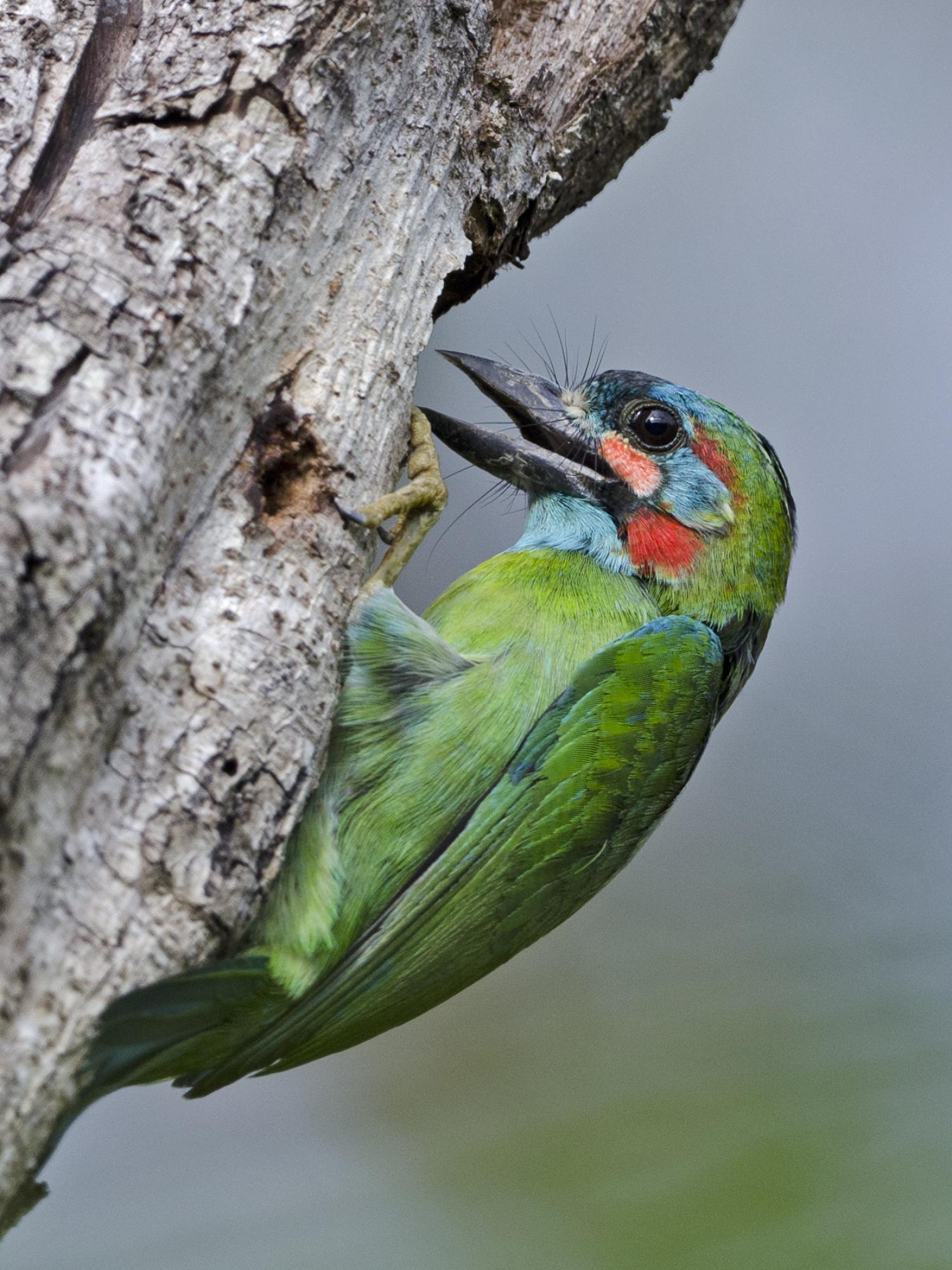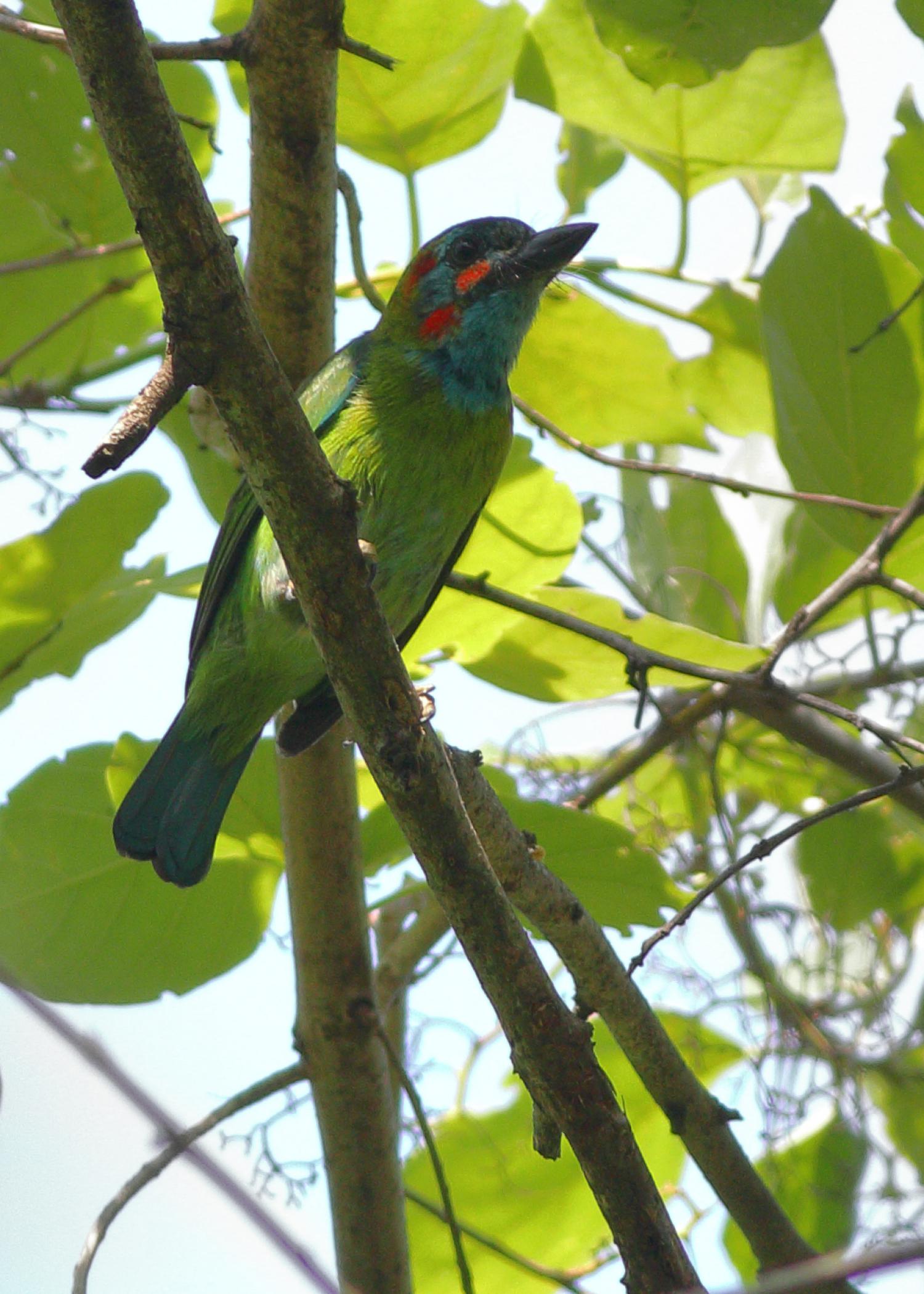Species of Thailand
Blue-eared barbet
Psilopogon duvaucelii
René-Primevère Lesson, 1830
In Thai: นกโพระดกหน้าผากดำ
The blue-eared barbet (Psilopogon cyanotis) is a barbet in the Megalaimidae family native to mainland Southeast Asia. Because of its wide distribution and stable population it is listed as Least Concern on the IUCN Red List.
Description
The blue-eared barbet has green plumage and crimson coloured spots on the cheeks. Its throat and ear-coverts are verditer-blue. A black band runs between throat and breast. It is 16 - 17 cm long.
It is a plump bird, with a short neck, large head and short tail. The bill is dark. The adult male has a black forehead. The female has a duller head pattern with a more orange tint to the patches above and below the ear coverts, and the juvenile has a green head with some blue on the ear coverts and throat.
The male's territorial call is a repeated loud ko-tek. Other calls include a whistled pleow.
Distribution and habitat
The blue-eared barbet is a resident breeder in the hills from eastern Nepal through northeast India to southern Thailand and Indochina. It inhabits shrublands and forests up to an altitude of 1600 m. It nests in a tree hole.
Taxonomy
Bucco cyanotis was the scientific name proposed by Edward Blyth in 1847 who described a barbet from the Arakan area.
In the 19th and 20th centuries, about 19 generic names were proposed for Asian barbet species, including Psilopogon by Salomon Müller in 1836, Megalaima by George Robert Gray in 1849 and Mezobucco by George Ernest Shelley in 1889. Taxonomists used different generic names when describing barbets in collections of natural history museums.
Mesobucco duvaugli orientalis was proposed by Herbert C. Robinson in 1915 for seven barbets collected on the coast at the Thailand-Cambodian border and on Ko Chang Island that differed from cyanotis barbets; they were larger and paler, and the red spot below their eyes was intermixed with golden.
Three blue-eared barbet subspecies are recognized as valid taxa since 2014:
- P. c. cyanotis – from southeastern Nepal, Bangladesh and northeastern India to Myanmar, northern Thailand and southern China
- P. c. orientalis – from eastern Thailand to Cambodia, Laos and Vietnam
- P. c. stuarti (Robinson & Kloss, 1919) – peninsular Thailand
This article uses material from Wikipedia released under the Creative Commons Attribution-Share-Alike Licence 3.0. Eventual photos shown in this page may or may not be from Wikipedia, please see the license details for photos in photo by-lines.
Category / Seasonal Status
BCST Category: Recorded in an apparently wild state within the last 50 years
BCST Seasonal status: Resident or presumed resident
Scientific classification
- Kingdom
- Animalia
- Phylum
- Chordata
- Class
- Aves
- Order
- Piciformes
- Family
- Megalaimidae
- Genus
- Psilopogon
- Species
- Psilopogon duvaucelii
Common names
- Thai: นกโพระดกหน้าผากดำ
Subspecies
Megalaima australis australis (nominate), Thomas Horsfield, 1821
Range: Java
Megalaima australis cyanea
Range: Mt. Kinabalu, north Borneo
Megalaima australis cyanotis, Edward Blyth, 1847
Megalaima australis duvaucelii, René-Primevère Lesson, 1830
Range: Malaysia, Sumatra, and the lowlands of Borneo
Megalaima australis gigantorhina, Harry Church Oberholser, 1912
Range: Nias Islands, west Sumatra
Megalaima australis hebereri
Range: Bali
Megalaima australis invisa
Range: Northern Thailand
Megalaima australis orientalis, Herbert Christopher Robinson, 1915
Range: Southeast Thailand and Indo-China
Megalaima australis stuarti, Herbert Christopher Robinson & Cecil Boden Kloss, 1919
Range: Western and central Thailand
Megalaima australis tanamassa, Rodolphe Meyer de Schauensee, 1929
Range: Batu Islands, west Sumatra
Synonyms
- Psilopogon cyanotis
- Megalaima duvaucelii
Conservation status

Least Concern (IUCN3.1)
Photos
Please help us review the bird photos if wrong ones are used. We can be reached via our contact us page.
Range Map

- Ao Phang-Nga National Park
- Ban Bueng District, Chonburi
- Bang Lamung District, Chonburi
- Bang Lang National Park
- Bueng Boraped Non-Hunting Area
- Chae Son National Park
- Chaloem Phrakiat Thai Prachan National Park
- Chaloem Rattanakosin National Park
- Chiang Dao District, Chiang Mai
- Chiang Dao Wildlife Sanctuary
- Chiang Saen District, Chiang Rai
- Doi Inthanon National Park
- Doi Pha Hom Pok National Park
- Doi Phu Kha National Park
- Doi Suthep - Pui National Park
- Erawan National Park
- Hala-Bala Wildlife Sanctuary
- Huai Kha Khaeng Wildlife Sanctuary
- Huai Yang Waterfall National Park
- Kaeng Khoi District, Saraburi
- Kaeng Krachan District, Phetchaburi
- Kaeng Krachan National Park
- Kaeng Krung National Park
- Khao Ang Rue Nai Wildlife Sanctuary
- Khao Banthat Wildlife Sanctuary
- Khao Chong
- Khao Khiao - Khao Chomphu Wildlife Sanctuary
- Khao Khitchakut National Park
- Khao Laem National Park
- Khao Lak - Lam Ru National Park
- Khao Luang National Park
- Khao Nam Khang National Park
- Khao Nan National Park
- Khao Phanom Bencha National Park
- Khao Phra - Bang Khram Wildlife Sanctuary
- Khao Phra Thaeo Wildlife Sanctuary
- Khao Pu - Khao Ya National Park
- Khao Soi Dao Wildlife Sanctuary
- Khao Sok National Park
- Khao Yai National Park
- Khlong Lan National Park
- Khlong Nakha Wildlife Sanctuary
- Khlong Phanom National Park
- Khlong Saeng Wildlife Sanctuary
- Khon San District, Chaiyaphum
- Khun Chae National Park
- Khura Buri District, Phang Nga
- Ko Chang National Park
- Kui Buri National Park
- Mae Moei National Park
- Mae Ping National Park
- Mae Wong National Park
- Muak Lek District, Saraburi
- Mueang Chanthaburi District, Chanthaburi
- Mueang Chiang Mai District, Chiang Mai
- Mueang Chumphon District, Chumphon
- Mueang Krabi District, Krabi
- Mueang Nakhon Nayok District, Nakhon Nayok
- Mueang Phang Nga District, Phang Nga
- Mueang Phuket District, Phuket
- Mueang Rayong District, Rayong
- Nam Nao National Park
- Namtok Phlio National Park
- Ngao Waterfall National Park
- Op Khan National Park
- Pachee River Wildlife Sanctuary
- Pang Sida National Park
- Pha Daeng National Park
- Phato District, Chumphon
- Phi Phi Islands
- Phu Foi Lom National Park
- Phu Hin Rong Kla National Park
- Phu Khiao Wildlife Sanctuary
- Phu Kradueng National Park
- Phu Langka National Park
- Phu Suan Sai National Park
- Phu Wiang National Park
- Sai Yok District, Kanchanaburi
- Sai Yok National Park
- Sakaerat Environmental Research Station
- San Kala Khiri National Park
- Si Racha District, Chonburi
- Sirinat National Park
- Sri Phang-nga National Park
- Su-ngai Kolok District, Narathiwat
- Tai Rom Yen National Park
- Taksin Maharat National Park
- Takua Pa District, Phang Nga
- Tha Yang District, Phetchaburi
- Thalang District, Phuket
- Thale Ban National Park
- Thap Lan National Park
- Thung Salaeng Luang National Park
- Thung Yai Naresuan Wildlife Sanctuary
- Ton Nga-Chang Wildlife Sanctuary
- Ton Pariwat Wildlife Sanctuary
- Umphang Wildlife Sanctuary
- Wang Mai Forest Restoration Project
- Wiang Lo Wildlife Sanctuary
- Yan Ta Khao District, Trang

